 |
Journal
of Regional Section of Serbian Medical Association in Zajecar
Year 2004 Volumen 29 Number
3 |
|
|
|
|
[ Home ] [ Gore/Up ][ <<< ] [ >>> ]
|
|
|
UDK: 616.441-008.61-084:546.15(497.11) |
ISSN 0350-2899, 29(2004) 3
p.144-149 |
|
| |
Original paperIncidence of Thyroid Diseases and Variation of
Neonatal TSH Values -
Influence of Iodine Content Correction?
Nebojša Paunković, Jane Paunković
Nuclear Medicine, Medical Centre Zajecar |
|
| |
|
|
| |
Summary:
Iodine prophylaxis implemented at the territory of former Yugoslavia in
1953, has successfully corrected previously existent mild iodine
deficiency in East Serbia. Clinical findings (incidence of goiter in
school children, ratio of diffuse to focal toxic goiters, uptake of 131I
in healthy persons) in subsequent decades were adequate for the areas with
corrected iodine deficiency. Iodine content in consume salt was increased
from 10mg KI/ kg to 20 mg KI/kg, for the entire territory of Serbia, by
federal legislation, in 1993. This report is presenting an occasional
investigation of variation in thyroid morbidity and neonatal TSH, in the
area of corrected iodine deficiency, in conditions of increasing iodine
consumption. Investigated parameters included: neonatal TSH, incidence of
autoimmune thyroid diseases (Graves'-Basedow disease, Hashimoto's
thyroiditis, primary hypothyroidism), and autonomous thyrotoxicosis
(Plummer's disease), incidence of goiter in school children, uptake of
131I in healthy persons, in the period 1978 - 2000. Results have
demonstrated that two years following the implementation of increased
iodization, findings of neonatal TSH decreased for average 40% and
incidence of autoimmune hyperthyroidism increased over 250%. In subsequent
two years, both parameters have recovered. Incidence of Hashimoto's
thyroiditis, primary hypothyroidism, and autonomous thyrotoxicos
(Plummer's disease) incidence of goiter in school children, was
unchanged. There is a considerable probability that modification of
thyroid morbidity was initiated by increased iodine consumption in the
region with previously corrected iodine deficiency, although other
factors could not be excluded.
Key words: iodine content correction, thyroid disease, neonatal TSH
Napomena: sažetak na srpskom jeziku
Note: summary in Serbian |
|
| |
|
|
| |
|
|
| |
INTRODUCTION
Authors have reported the significant increase of incidence of
autoimmune hyperthyroidism (Graves’ disease) in Region of East Serbia (Timok
Region) for the period 1994-1996 (1,2). The increase was authentic,
documented by correct diagnostic methodology (3). Feasible factors
influencing the increase in incidence were summarized: psychological
stress inflicted upon the population by the war in former Yugoslavia;
increased iodine consumption and Chernobyl accident.
The aim of this report is to supplement contemporary findings (four
years later), and further exploit the possibility of iodine influence in
induction of autoimmune hyperthyroidism. We have delineated iodine for
several reasons: a) Region of East Serbia was not iodine deficient,
(previously existent mild iodine deficiency was corrected by salt
iodization (10 mg/ kg of NaCl) implemented in 1953)(4,5);: b) new
regulation of iodine supplementation (20 mg KJ/kg NaCl) was introduced
in 1993(6) ; c) reports from 1953-1963 (the first introduction of iodine
prophylaxis in Serbia), indicated transitory increase in incidence in
hyperthyroidism including Graves’ disease (7). |
|
| |
|
|
| |
|
|
| |
METHODS
Registration of patients with Graves’ disease
Methods and registration technique for patients with Graves’ disease is
discussed in details in previous report (1). In summary, only patients
with clinically manifested Graves’ disease were registered. Diagnosis
was based on contemporary endocrinological, functional and
immmunological criterion (“free” thyroid hormones, "ultra sensitive" TSH, TSH receptor antibodies,
131I and 99mTc uptake, thyroid
scintigraphy). All diagnostic and clinical investigations were performed
in a single institution , and only permanent residents of the Timok
Region (before 1985), were included in this study. |
|
| |
|
|
| |
|
|
| |
STUDY DESIGN
- Investigation of parameters indicative of iodine status:
a) Thyroid morbidity: cumulative incidence of thyroid diseases from
Thyroid Disease Register. Continuous registration of thyroid diseases
(both autoimmune and non autoimmune was introduced in 1970 for the
patients from Timok Region (population of approximately 315,000
people)
b) Annual systematic examination of school children, (average number
of children per year was 2341
c) 131I uptake tests in healthy persons, performed on 411 of healthy
persons referred to thyroid service in a period form 1963-1973.
Euthyroid status was confirmed by clinical examination, T3 suppression
test, PB131I until 1970, and total T4 since 1970.
d) Neonatal TSH (1987-1999)(8) was performed as a part of Screening
for congenital hypothyroidism (Neonatal hTSH, DELFIA, WALLAC).
Samples from only one county (Zajecar) were included. Total number of
investigated samples was N= 5338. Cases of congenital hypothyroidism
were excluded from this study.
- Investigation of incidence of thyroid disease (autoimmune
and non autoimmune) and comparison with historical reports on
increased incidence of hyperthyroidism following iodine prophylaxis in
Yugoslavia (1953-1963).
|
|
| |
|
|
| |
RESULTS
Parameters indicative of iodine status
a) Thyroid morbidity
Cumulative incidence of thyroid diseases (both autoimmune and non
immune) in Timok Region for the period 1970-1993 is presented in Table1. |
|
| |
|
|
| |
| Disease |
Number of patients |
| Graves’ disease |
758 |
| Plummer’s disease |
169 |
| Hashimoto’s thyroiditis |
75 |
| Hypothyroidism |
135 |
| Nodular goiter |
1312 |
| Diffuse goiter |
152 |
| Thyroid cancer |
84 |
|
Table 1.
Cumulative incidence
of thyroid disease in Timok Region (1970-1993) |
|
| |
|
|
| |
b) Prevalence of goitre in school children for the period from
1970-1993
In the course of obligatory systematic examination of school children
special attention to goitre palpation was applied. Qualified
Thyroidologist trained all doctors involved in systematic examination of
children in period 1970-1975. Every year, around 2% of the children
were referred to Thyroid service and registered with the goitre. That
percentage remained unaltered for the entire investigated period
(1978-2000).
c) 131I Uptake tests for healthy persons
Value of 131I Uptake after 3 hours was 7-20% ( MV+ 3SD) and
Value of 131I Uptake after 24 hours was 20-45% ( MV+ 3SD).
e) Neonatal TSH
MV+ SD for the entire investigated period (1987-1998) was 2.17+ 1.98 mU/l
. Upper normal level was calculated as MV+ 2SD = 6.13 mU/l. Total number
of registered cases of TSH>6 mU/l for the entire period was 137 (2.93%);
for period 1987-1993 total number was TSH>6 mU/l was 96 (3.1%) and for
period 1984-1998 total number was TSH>6 mU/l was 41 (2.5%) . |
|
| |
|
|
| |
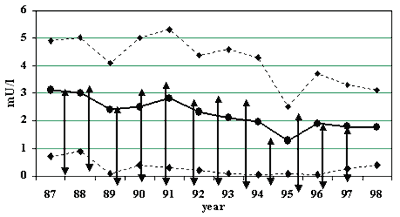
Graph 1. Neonatal TSH (MV+ SD) for investigated period
(1987-1998)
Comparative results of calculated mean values of neonatal TSH for the
period 1987-1993 and 1994-1998 are presented on Graph 2 and comparative
profiles of the Neonatal TSH values between two investigated periods on
Graph 3.
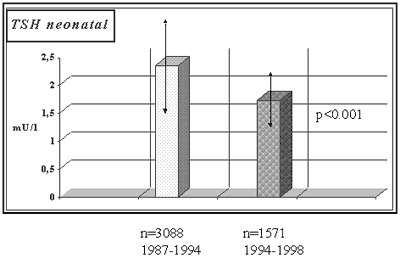
Graph 2. Mean values (MV+SD) of Neonatal TSH for period from
1987-1993 compared to mean values (MV+SD) for period from 1994-1998
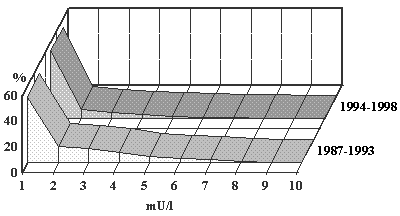
Graph 3. Comparison of frequency distribution between
Neonatal TSH values for two investigated periods |
|
| |
|
|
| |
|
|
| |
2. Comparative analysis of increase incidence of hyperthyroidism
following the implementation of iodine prophylaxis 1953-1963 and
1993-2000 Increased incidence of hyperthyroidism was reported
subsequent to implementation of the iodine prophylaxis in 1953.
Honouring the memory of Professor Kicic we supplement the results of his
report (7) on Graph 6 for comparison with our contemporary findings on
Graph 4 and Graph 5 .
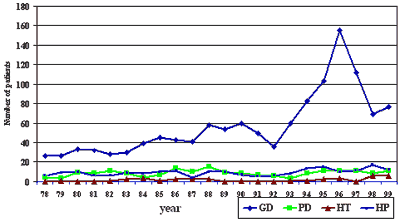
Graph 4. Incidence of autoimmune and non-immune thyroid diseases
(1978-2000)
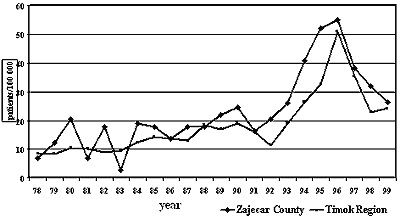
Graph 5. Comparative standardized incidence of Graves’ disease
for the Timok region and central county (Zajecar) |
|
| |
|
|
| |
|
|
| |
DISCUSSION
Studies and reports on interrelation of thyroid morbidity and iodine
status are numerous (9-12). Data from experimental (13,14) and
epidemiological surveys (15-18) is available. Discussions on the subject
generally become substantial in a course of a decision-making about
iodine supplementation or correction (19-23).
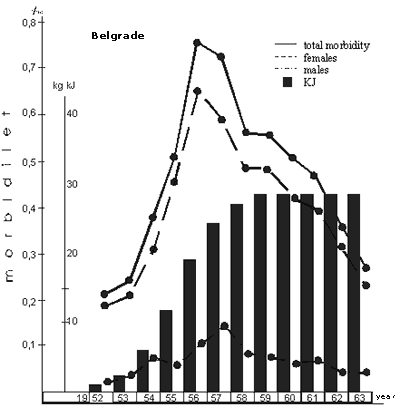
Graph 6. Incidence of hyperthyroidism following the first
implementation
of iodine prophylaxis (adopted from Kicic report (7))
Correction of severe iodine deficiency in addition to elimination of
endemic thyroid dystrophy (goiter and cretinism) was reported to induce
hyperthyroidism, (generally regional thyroid autonomy -Plummer’s
disease) in cases of existent euthyroid polynodular goiter (24-26).
Increase in incidence of Graves’ disease is less frequently well
documented (27-30).
Evidently, there are open questions about the effect of mild iodine
deficiency correction on thyroid morbidity, especially induction of
hyperthyroidism, and ultimately about the impact of iodine content
increase in a population, in area that is not iodine deficient.
The first question has been adequately addressed by Austrian
investigators, recently. They observed the implementation of increase in
KJ content in consume salt (from 10 to 20mg KJ/kg NaCl) and reported
increase in incidence of Graves’ disease (27). Analogous observation was
reported from Lebanon (28). A historical report from 1964, by Kicic
(reported only in Serbian Journal) indicated a transitory increase in
incidence of Graves’ disease in areas without endemic goitre (7).
We have observed multiple increase in incidence of Graves’ disease in
Timok Region (East Serbia) with maximum in 1996 (152 patients registered
compared with regular incidence of 35-40 patients from 1980 to 1994).
Appreciating the complexity of pathogenetic factors of Graves’ disease,
this report is just an attempt to presume the capacity of iodine in
observed increase of incidence of the Graves’ disease.
Summarizing the approving factors of the potential influence of iodine
correction:
Iodine prophylaxis implemented in 1953 (10 mg KI per kg of salt, and
since 1963 per kg of salt for human consumption) successfully corrected
existent mild iodine deficiency in Timok Region. This statement is
documented by:
- Low prevalence of euthyroid goitre in school children (around 2 %);
Average 131I tests in healthy persons adequate for areas without iodine
deficiency;
Low incidence of elevated Neonatal TSH values (around 3%).
Two years after the implementation of the second iodine content
correction (from 10 to 20mg KI/kg NaCl in 1993) we have registered the
increase in incidence of Graves’ disease, which attained the maximum in
1996. Increase in incidence of Graves’ disease was transitory and by
2000 numbers of registered cases relapsed to values from 1992. These
findings are analogues to report following iodine prophylaxis in 1953
(7).
Statistically significant decrease in mean values of Neonatal TSH was
registered for the period 1994-1999 compared with period 1988-1993, with
the evident minimum in 1995.There was no significant alteration in
frequency of distribution of normal values between investigated periods.
Benefits of iodine supplementation programs have been extensively
reviewed (31,32,33) and are undisputable. There is a general agreement
that development of Graves’ disease depends on complex interaction
between genetic and environmental factors (including iodine intake), but
more studies are required to elucidate the exact mechanism. In spite of
maxima ""Post hoc" is not necessarily "Propter hoc"", authors believe
that it is synonymous in this observation and that every potential
environmental change requires cautious consideration. |
|
| |
|
|
| |
|
|
| |
REFERENCES
- Paunkovic N, Paunkovic J, Pavlovic O, Paunovic Z. The significant
increase in incidence of Graves’ disease in Eastern Serbia during the
civil war in the former Yugoslavia (1992 to 1995). Thyroid 1998; 10:
37-41.
- Paunkovic J, Paunkovic N. Continuous monitoring of the autoimmune
thyroid disease during 20 years: epidemic increase in incidence of
Graves’ disease in last 25 years, during and after the civil war in
former Yugoslavia. J Endocrinol Invest 1998; 21 (suppl to No 4): 63
abstr 126.
- Leclere JF. Stress and autoimmune thyroid disease, In: Peter F.
Wiersinga W. Hostalek U. The Thyroid and Environment. Schattauer,
Stuttgart-New York 2000. p. 155-162.
- Ramzin S, Alekovic G. Characteristics of struma in epicentres of
endemic goitre. Hygiene VII . II Congress of preventive medicine.
Beograd 1956, 284-294
- Sinadinovic J, Han R. Iodine deficiency, endemic goitre and iodine
prophylaxis. Politop, Beograd, 1995.
- Regulations on quality of consume salt and salt for food industry.
Sl glas SRJ 7/93.
- Kicic M. Problems of hyperthyroidism in a course of iodine
prophylaxis for endemic thyropathic dystrophy. Vojnosanitetski pregled
1977; 6: 409-421
- Delange F. Screening for congenital hypothyroidism as indicator of
IDD control. In: Pinchera A., Mann K, Hostalek U. The Thyroid and Age,
Schattauer, Stuttgart-New York 1998. 122-132.
- Stanbury JB, Ermans AE, Bourdoux P. Todd C. Oken E. Tonglet R.
Vidor, Braverman LE. Medeiros-Neto G. Iodine-induced hyperthyroidism:
occurrence and epidemiology. Thyroid 1998; 8:1,83-100.
- Braverman LE. Iodine and thyroid: 33 years of study. Thyroid 1994;
4: 351-356.
- Dunn JT, Semigran MJ, Delange F. The prevention and management of
iodine-induced hyperthyroidism and its cardiac features. Thyroid 1998;
8(1): 101-6.
- Foley TP. The relationship between autoimmune t hyroid disease and
iodine intake. Endokrynol Pol 1992; 43 Suppl 1(6): 53-69.
- Paschke R, Vogg M, Winter J, Wawschinek O, Eber O, Usadel KH. The
influence of iodine on the intensity of the intrathyroidal autoimmune
process in Graves' disease. Autoimmunity 1994; 17(4): 319-25.
- Saller B, Fink H, Mann KT. Kinetics of acute and chronic iodine
excess. J Exp Clin Endocrinol Diabetes 1998; 106(Suppl 3): 34-8.
- Laurberg P, Pedersen KM, Vestergaard H, Siggurdsson G. High
incidence of multinodular toxic goiter in the elderly population in a
low iodine intake area vs. high incidence of Graves’ disease in the
young in a high iodine intake area: comparative surveys of
thyrotoxicosis epidemiology in East-Jutland Denmark and Iceland. J
Intern Med 1991; 229: 415-420.
- Laurberg P, Nohr SB, Pedersen KM, Hreidarsson A, Andersen S, Bulow
Pedersen I, Knudsen N, Perrild H, Jorgensen Ovesen L. Thyroid
disorders in mild iodine deficiency. Thyroid 2000 Nov; 10(11): 951-63.
- Tunbridge WHG, Calowell G. 1991 The epidemiology of thyroid
diseases. In: Braverman LE, Utiger R.D. (eds): The Thyroid: A
Fundamental and Clinical text, 6th ed. Philadelphia, Lippincot p 578.
- Subcommittee of the European Thyroid Association for the study of
endemic goiter and iodine deficiency. Goiter and iodine deficiency in
Europe. Lancet 1985; 1:1289-1293.
- Garcia-Mayor RV, Rios M, Fluiters E, Mendez L, Garcia-Mayor EG,
Andrade A. Effect of iodine supplementation on a pediatric population
with mild iodine deficiency. Thyroid 1999 Nov; 9(11): 1089-93.
- Ozbakir O, Dogukan A, Kelestimur F. The prevalence of thyroid
dysfunction among elderly subjects in an endemic goiter area of
Central Anatolia. Endocr J 1995 Oct; 42(5): 713-6.
- Gaitan E, Nelson NC, Poole GV. Endemic goiter and endemic thyroid
disorders. World J Surg 1991 Mar-Apr; 15(2): 205-15.
- Ramzin S. Endemic goitre, epidemiological and etiological problems
in our country. The First Symposia on endemic goitre. Beograd 1959;
27-60.
- Deckart H, Deckart E, Behringer F, Kuhne H, Adam B, Apitz H,
Eifler H, Grambow H, Hannemann R, Hans R, et al. Incidence of autonomy
and immune hyperthyroidism before and following preventive use of
iodized salt in the Berlin-Brandenburg area. Acta Med Austriaca 1990;
17 Suppl 1(1): 39-41.
- Adams DD, Kennedy TH, Stewart JC, Utiger RD, Vidor GJ.
Hyperthyroidism in Tasmania following iodide supplementation:
measurements of thyroid-stimulating autoanti-bodies and thyrotropin.
Clin Endocrinol Metab 1975 Aug; 41(2): 221-8.
- Gomo ZA, Allain TJ, Matenga JA, Ndemere B, Wilson A, Urdal P.
Urinary iodine concentrations and thyroid function in adult
Zimbabweans during a period of transition in iodine status. J Am J
Clin Nutr 1999; 70: 5, 888-91.
- Burgi H, Kohler M, Morselli B. Thyrotoxicosis incidence in
Switzerland and benefit of improved iodine supply. Letter Lancet 1998
Sep 26; 352(9133): 1034.
- Mostbeck A, Galvin G, Bauer P et al. The incidence of
hyperthyroidism in Austria from 1987 to 1995 before and after an
increase in salt iodization in 1990. EJNM 1998; 25: 368-374.
- Macaron C. An epidemic of hyperthyroidism following salt
iodination in Lebanon. J Med Lebanon 1996; 44: 200-202.
- Galofre JC, Garcia Mayor RV, Fluiters E, Fernandez Calvet L, Rego
A, Paramo C, Andrade MA. Incidence of different forms of thyroid
dysfunction and its degrees in an iodine sufficient area. Thyroidology
1994; 6: 49-54.
- Lamberg BAT. Endemic goitre in Finland and changes during 30 years
of iodine prophylaxis. J Endocrinol Exp 1986; 20: 1, 35-47
- Delange F, Lecomte P. Iodine supplementation: benefits outweigh
risks. Drug Saf 2000; Feb 22(2): 89-95.
- Delange F, de Benoist B, Alnwick D. Risks of iodine-induced
hyperthyroidism after correction of iodine deficiency by iodized salt.
1999; Thyroid 9: 6 545-56.
- Vitti P, Rago T, Aghini-Lombardi F, Pinchera A. Efficacy and
safety of iodine prophylaxis. J Ann Ist Super Sanita 1998; 34,
3:357-61.
|
|
| |
Corresponding Address:
Jane Paunković
Javorska 5, 19000 Zaječar
e-mail: mcza@sezampro.yu |
|
| |
|
|
| |
Paper received: 12. 08. 2004.
Paper accepted: 02. 09. 2004.
Published online: 18. 09. 2004. |
|
|
|
|
|
|
|
|
|
|
|
[ Home ] [ Gore/Up ][ <<< ] [ >>> ]
|
|
|
Infotrend Crea(c)tive Design |
|
|
|
Revised:
20 May 2009
|
|
|
|
|
|
|
|
|
|
|
|
|
|
|
|
|
|
|
|
|
|
|
|
|
|
|
|
|
|
|
|
|
|
|
|
|
|
|
|
|
|
|
|
|
|
|
|
|
|
|
|
|
|
|
|






